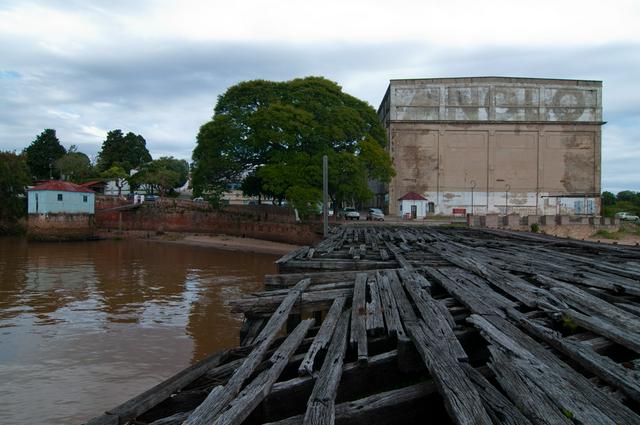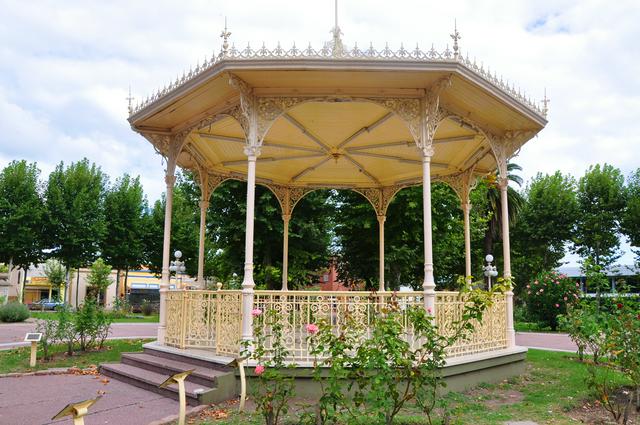Fray Bentos is in Río Negro department of Uruguay, at the border with Argentina. The town is best known, at least among travellers, for its former meat-packing plant, which is now a UNESCO World Heritage Site.
 The town of Fray Bentos has historically been a very important center of meat and meat extract production, as reflected in the world heritage listed plants located here.
The town of Fray Bentos has historically been a very important center of meat and meat extract production, as reflected in the world heritage listed plants located here.
The bus terminal, lodging, and most of the stuff in Fray Bentos is located in the downtown area, which faces the Uruguay River. As in other riverside Uruguayan towns, there is a waterfront path (rambla or costanera). But the most famous tourist attraction is in the World Heritage–listed Anglo Neighborhood (Barrio Anglo), located on the river a kilometer or two west of downtown.
The Anglo Neighborhood (Barrio Anglo) is the historic district including the industrial landscape that was declared a World Heritage Site in 2015. The star attraction is the museum, but it's worth wandering around the neighborhood a bit, especially the large former meat-packing plant.
- Museo de la Revolución Industrial, Rambla Andres Montaño, +598 4562 2918. Tu–Su 09:30–17:00. The UNESCO World Heritage listing "Fray Bentos Cultural Industrial Landscape" comprises the premises of the former Liebig's Extract of Meat Company, founded in 1863. From 1899 onwards the Anglo Meat Packing Plant functioned here. In its heyday it was one of the largest industrial plants in all of South America and attracted many of the region's European immigrants in the late 19th and early 20th centuries. Closed in 1979, the area now includes this extensive museum of the plant's history. The displays are mostly in Spanish, but a few are in English. $50 entrance fee, $120 for a guided tour.
- Barrio Obrero. The area east of the industrial complex is where the workers lived. Together with the industrial complex itself, it formed a particularly large company town.
- Casa Grande. Tours available Th Sa Su 11:00. House built starting in 1868. Inhabited by Liebig's managers when the plant was operating.
- Zona de Romerías. A nature area overlooking the river that is also of historic value. Celebrations of the end of the sugar harvest were once held here. Tent camps were set up, and people of all classes of society would participate in the festivities, including from neighboring cities. The space is now available for public use.
- Puerto Anglo, Ruta Panorámica. The company's old port (or what's left of it). Originally there were two docks used by the Anglo company, but they were joined into one. Later damaged by a fire and a flood, it was never fully repaired and is now a crumbling fragment of the former structure. It has two old rusted cranes and is located pretty close to the museum.
- ANGLO meat processing plant in action. Photo exhibition along a walkway in the industrial plant, with interesting black-and-white photos of the plant in its heyday.
Museo de la Revolución Industrial, Rambla Andres Montaño, +598 4562 2918. Tu–Su 09:30–17:00. The [[UNESCO World Heritage]] listing "Fray Bentos Cultural Industrial Landscape" comprises the premises of the former Liebig's Extract of Meat Company, founded in 1863. From 1899 onwards the Anglo Meat Packing Plant functioned here. In its heyday it was one of the largest industrial plants in all of South America and attracted many of the region's European immigrants in the late 19th and early 20th centuries. Closed in 1979, the area now includes this extensive museum of the plant's history. The displays are mostly in Spanish, but a few are in English. $50 entrance fee, $120 for a guided tour.
Barrio Obrero. The area east of the industrial complex is where the workers lived. Together with the industrial complex itself, it formed a particularly large company town.
Casa Grande. Tours available Th Sa Su 11:00. House built starting in 1868. Inhabited by Liebig's managers when the plant was operating.
Zona de Romerías. A nature area overlooking the river that is also of historic value. Celebrations of the end of the sugar harvest were once held here. Tent camps were set up, and people of all classes of society would participate in the festivities, including from neighboring cities. The space is now available for public use.
Puerto Anglo, Ruta Panorámica. The company's old port (or what's left of it). Originally there were two docks used by the Anglo company, but they were joined into one. Later damaged by a fire and a flood, it was never fully repaired and is now a crumbling fragment of the former structure. It has two old rusted cranes and is located pretty close to the museum.
ANGLO meat processing plant in action. Photo exhibition along a walkway in the industrial plant, with interesting black-and-white photos of the plant in its heyday.
 The downtown area (centro) has the feel of a typical Uruguayan city. Like other department capitals, it has its share of attractions worth seeing, but none are as impressive as the industrial plant in the Anglo neighborhood. Some things downtown were paid for by Liebig's, the company that owned the meat packing plant.
The downtown area (centro) has the feel of a typical Uruguayan city. Like other department capitals, it has its share of attractions worth seeing, but none are as impressive as the industrial plant in the Anglo neighborhood. Some things downtown were paid for by Liebig's, the company that owned the meat packing plant.
- Museo Solari, Treinta y Tres Orientales 1879, +598 4562 1057. M–F 8:00–20:00, Sa Su holidays: 14:00–20:00. Art museum, mostly featuring the work of the Uruguayan painter Luis Alberto Solari, who was born in Fray Bentos. His signature theme is figures with human-looking bodies but animal heads or masks. In addition to a substantial collection of his work, the museum has two rooms of paintings by other Uruguayan artists. Free.
- Parroquia Nuestra Señora del Pilar, 25 de Mayo (next to Plaza Constitución. A church, financed by Liebig's, that includes a clock imported from France.
- Plaza Constitución, 15 de Mayo and 18 de Julio. Beautiful plaza with a gazebo at its center. The gazebo, unique in Uruguay and originally built in England, was financed by Liebig's.
- Teatro de Verano. An amphitheater by the water, surrounded by a park. Sometimes there'll be some kind of community event going on, or a performance. Even when there isn't, it's a nice place to relax and drink mate.
- Teatro Young, Zorrilla de San Martín and 25 de Mayo.
Museo Solari, Treinta y Tres Orientales 1879, +598 4562 1057. M–F 8:00–20:00, Sa Su holidays: 14:00–20:00. Art museum, mostly featuring the work of the Uruguayan painter Luis Alberto Solari, who was born in Fray Bentos. His signature theme is figures with human-looking bodies but animal heads or masks. In addition to a substantial collection of his work, the museum has two rooms of paintings by other Uruguayan artists. Free.
Parroquia Nuestra Señora del Pilar, 25 de Mayo (next to Plaza Constitución. A church, financed by Liebig's, that includes a clock imported from France.
Plaza Constitución, 15 de Mayo and 18 de Julio. Beautiful plaza with a gazebo at its center. The gazebo, unique in Uruguay and originally built in England, was financed by Liebig's.
Teatro de Verano. An amphitheater by the water, surrounded by a park. Sometimes there'll be some kind of community event going on, or a performance. Even when there isn't, it's a nice place to relax and drink mate.
Teatro Young, Zorrilla de San Martín and 25 de Mayo.
Because this is a border town, some places will accept Argentinian pesos and even US dollars.
- El Inmigrante, 18 de Julio 1118, +598 4562 0774. Typical Uruguayan food: pizza, pasta, milanesas, etc.
El Inmigrante, 18 de Julio 1118, +598 4562 0774. Typical Uruguayan food: pizza, pasta, milanesas, etc.
- Gualeguaychú – across the bridge in Argentina
- Colonia – home to Uruguay's other World Heritage site, an old colonial city founded by the Portuguese
[[Gualeguaychú]] – across the bridge in [[Argentina]]
[[Colonia]] – home to Uruguay's other World Heritage site, an old colonial city founded by the Portuguese
